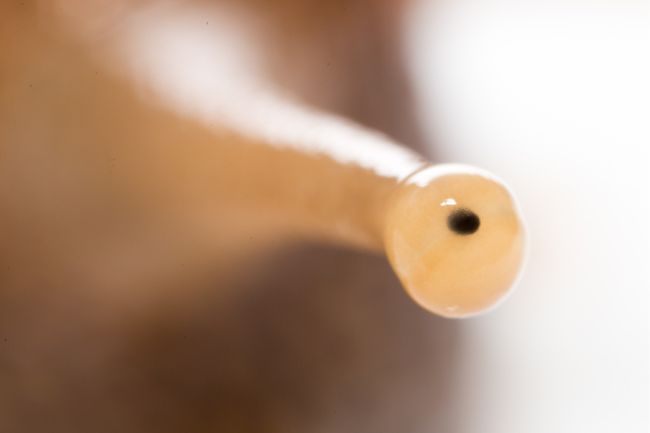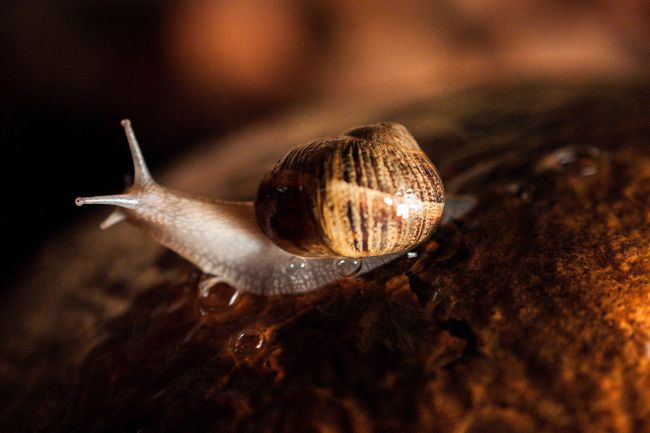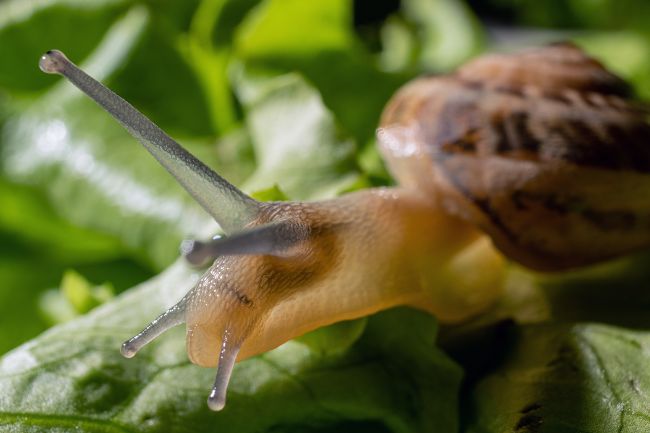Snails do have eyes. In landsnails these are located on their tentacles, while in sea snails they can either be on tentacles or on the body of the snail.
Do snails have eyes?
Look closely at a snail and you may be mistaken in thinking that they do not have eyes. Indeed, the eyes of most snails are only a few millimetres across, and so can easily be missed, particularly in smaller species. However, look closely and you might just see the snail staring right back at you.
| Snail Species | Eye Type | Additional Information |
|---|---|---|
| Garden Snail | Simple Eyes | Detect light and movement |
| Roman Snail | Complex Eyes | Can distinguish shapes, colors, and light intensity |
| Cone Snail | Compound Eyes | Provide a wide field of vision and detect predators and prey |
| Tree Snail | Pinhole Eyes | Capable of detecting changes in light and dark |
| Pond Snail | Simple Eyes | Detect changes in light and motion |
The majority of snail species do have eyes, though some species, usually those living in permanently dark environments such as caves, do not. Many invertebrates have fairly simple eyes, however, many snails have relatively complex eyes given their size. Interestingly, across the mollusc family tree, which snails are a part of, we can track the evolution of the eye, from a very basic structure to a more complex.

In its more basic form the eye is simply a group of photoreceptors, placed on the surface of the skin to detect light and dark. These photoreceptors then multiple and become part of a sunken structure in the skin. This makes it easier to detect where light is coming from, and this form of eye can be found in limpet species. Over time this cup deepens and the entrance hole for the light becomes smaller. This pinpoint light source again helps to focus the light further. Top shells are an example of this more evolved eye.
The final step is for this pinpoint opening to be covered over with a translucent film, and the cavity behind to become filled with fluid. This bubble eye is found in many marine snails. Land snails have a very similar eye structure, however, the bubble eye is given additional clarity by the addition of a lens. Surprisingly this vesicular eye isn’t that dissimilar in design from our own eyes.
The key difference between our eyes and the eyes of land snails is that we have muscles attached to our lens. These muscles can make the lens change shape, allowing us to focus on different things before us. Snails lack this muscle, meaning their vision is much more blurry and less focused. Interestingly the next step up in the mollusc eye evolution are the eyes of species such as squid, who have excellent vision.
| Snail Species | Habitat | Eye Adaptations | Additional Information |
|---|---|---|---|
| Desert Snail | Arid regions | Eyes with thickened cuticle and narrow slits to minimize water loss | Protects the eyes from dehydration and excessive evaporation |
| Aquatic Snail | Freshwater | Large and protruding eyes for better vision in water | Helps detect predators, find food, and navigate through aquatic environments |
| Tree Snail | Forest canopies | Eyes on retractable stalks, allowing them to scan their surroundings from different angles | Provides a wider field of vision for detecting threats or food sources |
| Cave Snail | Dark caves | Degenerated or absent eyes due to the absence of light | Adapted to a lightless environment with alternative sensory mechanisms |
| Land Snail | Terrestrial | Eyes located at the tips of long tentacles, providing a broader range of vision and detecting vibrations | Enhances their ability to sense their surroundings and potential dangers |
Where the eyes are located varies throughout different kind of snail species. On land snails they are positioned on the stalk-like tentacles on their heads. These tentacles allow manual movement of the eyes, which can help them to physically focus on objects to some extent.
The stalks are also important to help protect their eyes. Snails have the amazing ability to fully retract their eyes, and their eye stalks, into their bodies. This is a great way to look after their eyes and prevent them from getting harmed. The eye stalks can also regenerate if they are damaged, however, the replacement eye may not have the full functionality of the old eyes.
Most land snails will have two pairs of tentacles on their heads. The top tentacles are those that have the eyes. These tentacles don’t serve any other purpose for the snail in terms of sensory tasks. The second, smaller and lower down set, is where the other sensory organs are, in particular their sense of smell.
While land snails have their famous tentacles, sea snails may locate their eyes a wide range of places. Some do have them located on eye stalks, however these are often used largely to peer out of their shell when they have retreated there for safety.

Conchs, large and predatory sea snails, are believed to have particularly good eyesight, in order to help them hunt their prey. Whereas most snails are believed to see blurry patterns of light and dark, conchs are thought to reproduce an image with their large eyes. The limpet, by comparison, has only an eye spot with pigment cells to detect light.
Also read: Keeping Snails as a Pet: Sea, Land & Exotic Species
What’s their purpose?
Within the snail’s eyes there are two types of photoreceptor. As both have detect a similar wave-length of light, it is believed that snails cannot see in colour, and instead detect levels of light. In order to hide from predators, and to avoid drying out, snails are also more attracted to dark places, and will move towards darker areas when given a choice.
| Eye Component | Function | Additional Information |
|---|---|---|
| Retina | Receives light and converts it into nerve impulses | Contains light-sensitive cells called photoreceptors |
| Optic Nerve | Transmits visual information from the retina to the snail’s brain | Enables the brain to process and interpret visual signals |
| Eye Stalk | Holds the eye and allows it to move for better vision | Some snails can retract their eyes into their shells |
| Pigment Cells | Control the amount of light entering the eye and protect it from excessive brightness or harmful rays | Pigment cells provide eye color and protect against UV damage |
As the vision in most species is likely to be fairly blurry, snails do not rely on their sight as a key sense. Instead their sense of smell is often much more important.

Some land snails have been found to have two eyes on each of their eye stalks. Their main eye, and a smaller secondary eye. It isn’t yet clear how this secondary eye is used, though it may be a more basic light sensing organ.
Where are snail eyes located?
For the majority of land snails, and many marine and freshwater snails, their eyes are at the end of their eye stalks or tentacles on their heads. The location of the eyes on the stalks gives the snail an amazing ability to manuver their eyes to look both in front and behind them. This gives the snail a much wider field of vision without needing to turn their heads.
The final addition to the snail’s light sensing abilities is the large number of light sensing photoreceptors located across their body. These are much more simplistic than their eyes, simply registering a change in light levels. This can be a lifesaving tool, as the sudden appearance of a shadow may indicate that there may be a predator about to attack. This quick warning allows them to retreat into their shell, away from danger.

Also read: Is Snail Vertebrate or Invertebrate? (Let’s Find Out)
How many eyes does a snail have?
Most snails have two main eyes, one eye on each of their eye stalks, and two accessory eyes. Some snails only have one eye.
Here’s looking at you…
Look at the world through a snail’s eyes and you’ll certainly see something somewhat different to what we can see. A blurry world of black and white, where the difference between light and dark is more important than the details.
For the majority of snails their prey is imobile, being made up of plants, or rotting debris. The hunt for them can be slow, with snails focusing on smell to locate their meals. Where vision is more important is in protecting themselves. There are many animals that will happily munch down on a snail.
Being able to see the shadow of a predator, and retreat quickly into their shell, may be the difference between life and death. So while they may not be able to see a complex image, they can see what they need to to stay alive.

